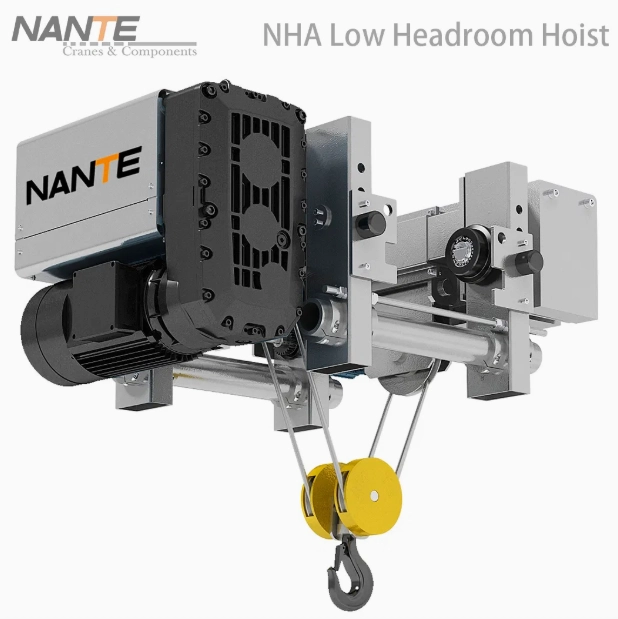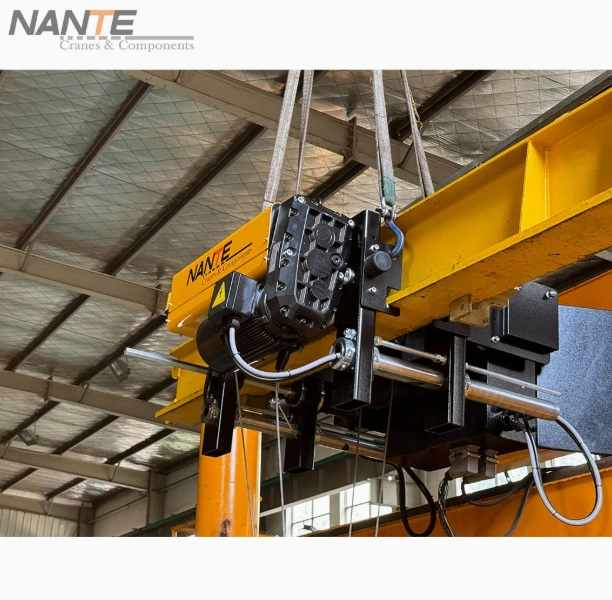How Can Low Headroom Hoists Maximize Efficiency in Tight Spaces?
How Can Low Headroom Hoists Maximize Efficiency in Tight Spaces?
Date: 2025-07-31 Share:
Introduction to Space Constraints in Industrial Settings
In warehouses, factories, and workshops, vertical space is super precious. It’s often tight. Regular overhead cranes need lots of headroom to work. That makes them tricky for places with low ceilings or packed setups. Low headroom hoists are a game-changer. They shrink the gap between the crane bridge and the load. These nifty systems turn tight spaces into chances for smoother work and more storage.
I. What Defines a Low Headroom Hoist?
Core Design Principle
Unlike regular hoists, low headroom ones mix the trolley and hoist into one tiny unit. It sits beside the bridge beam, not below it. This cuts down the system’s height big time—the space the crane takes up.
Critical Measurements
True low headroom designs get the hook super close to the ceiling, as little as 30 cm. Standard models need 60 cm or more. Key parts include:
- Side-mounted trolley frames: Set along the beam to keep the profile low.
- Flattened drum assemblies: Made small but still tough.
- Short-stroke lifting motors: Built for zippy work in cramped spots.
Material Innovations
Strong alloys and sturdy box-girder beams keep things solid despite the small size. They can lift up to 32 tons in some setups.
II. Efficiency Gains in Tight Spaces: 5 Key Advantages
- Maximized Vertical Storage: These hoists free up overhead space. Facilities can add taller racks or extra work levels. For example, a place with 3-meter ceilings might gain 0.6 meters. That’s enough for another storage row, boosting capacity a ton.
- Enhanced Maneuverability: The compact build has curvy wheels. They glide smoothly on narrow beam flanges, even on twisty tracks. This lets workers place loads exactly in crowded spots without bumps, speeding up work.
- Reduced Facility Modification Costs: Regular cranes often need pricey roof changes. Low headroom hoists fit in existing setups, slashing setup costs by up to 40%. That’s super cost-friendly.
- Ergonomic & Safety Benefits: Wireless controls let workers guide loads from the best spots, easing neck strain. Plus, dual brakes and overload protection make tight zones safer, cutting accident risks.
- Energy and Maintenance Savings: Cool AC/DC motors with variable-frequency drives (VFD) use 15–20% less power. Closed gears keep out dust, stretching service time and lowering upkeep costs.
III. Technical Specifications: Matching Hoists to Needs
Table: Low Headroom Hoist Configuration Guide
| Parameter | Standard Range | Custom Solutions |
| Lifting Capacity | 0.5 – 32 tons | Up to 50+ tons |
| Lifting Height | 3 – 30 m | Beyond 30 m |
| Headroom Reduction | 30 – 60 cm | Ultra-low: <30 cm |
| Travel Speed | 20 m/min (single-speed) | Variable-speed options |
| Control Methods | Pendant, Wireless Remote | Cabin + Remote hybrid |
Nante’s NHA series wire rope hoists are built for low headroom jobs. They’re compact, quiet, and sip power. Special versions include:
- Explosion-Proof Units: Great for chemical plants or grain silos.
- Corrosion-Resistant Kits: Have galvanized chains and C5-rated paint for wet places.
- Modular Trolleys: Come in manual or motorized styles for flexible tracks.
These specs make low headroom hoists super versatile and reliable for all sorts of industrial needs. Check Nante’s hoists.
IV. Industry Applications: Where Space Savings Matter Most
Low headroom hoists shine in places where vertical space is tight. Some cool uses include:
- Warehousing & Logistics: In spots with ceilings under 5 meters, these hoists let pallets stack high without squeezing aisle space. A Swiss timber warehouse boosted storage by 30% with cantilever racks and compact hoists. That’s big-time space saving.
- Automotive Assembly Lines: Side-mounted hoists are key for fitting engines or dashboards in tight pits where big cranes can’t go, keeping assembly quick and spot-on.
- Renovation/Historic Buildings: In old factories with low ceilings, like pre-1940s ones, these hoists handle materials without needing building changes, keeping history intact while adding function.
These uses show how low headroom hoists tackle space issues across different industries.
V. Spotlight: Industry-Leading Crane Solutions Provider
Nante Crane is one of China leading crane and crane components designer and manufacturer. Nante Crane, based in China with a global reach, rocks at making overhead lifting systems for tough industrial challenges. Their lineup includes:
- Advanced Low Headroom Cranes: With ultra-tiny trolleys and custom lift heights.
- End-to-End Services: From planning studies to ISO-certified making and upkeep.
- Innovation Focus: Patented safety gear like dual brakes and smart overload protection.
Nante’s solutions maximize space without losing load power, perfect for tight spots.
VI. FAQ: Low Headroom Hoist Essentials
Can low headroom hoists handle heavy loads?
Yup, modern designs lift up to 32 tons standard. Custom ones go beyond 50 tons.
Do they work on curved tracks?
Totally. Special trolleys with tapered wheels zip around curves as tight as 1.5 meters.
What’s the minimum ceiling height?
Some systems work with ceilings as low as 2.5 meters, if beam clearances are set right.
Are these hoists compatible with automation?
For sure. They hook up with IoT sensors and auto-positioning systems more and more.
Conclusion: Rethinking Vertical Real Estate
Low headroom hoists turn tight spaces into big wins. They cut wasted space above loads, boosting storage, smoothing work, and upping safety—all without pricey building changes. As industries deal with rising space costs and cramped facilities, these systems are a smart, future-ready choice.
Ready to Optimize Space?
- Consult a Specialist: Get a free check to spot headroom savings.
- Download Specifications: Grab technical drawings and load charts for exact planning.
- Schedule a Demo: See low headroom hoists in action at a test site.
Maximize every meter—reach out for a custom solution today.





